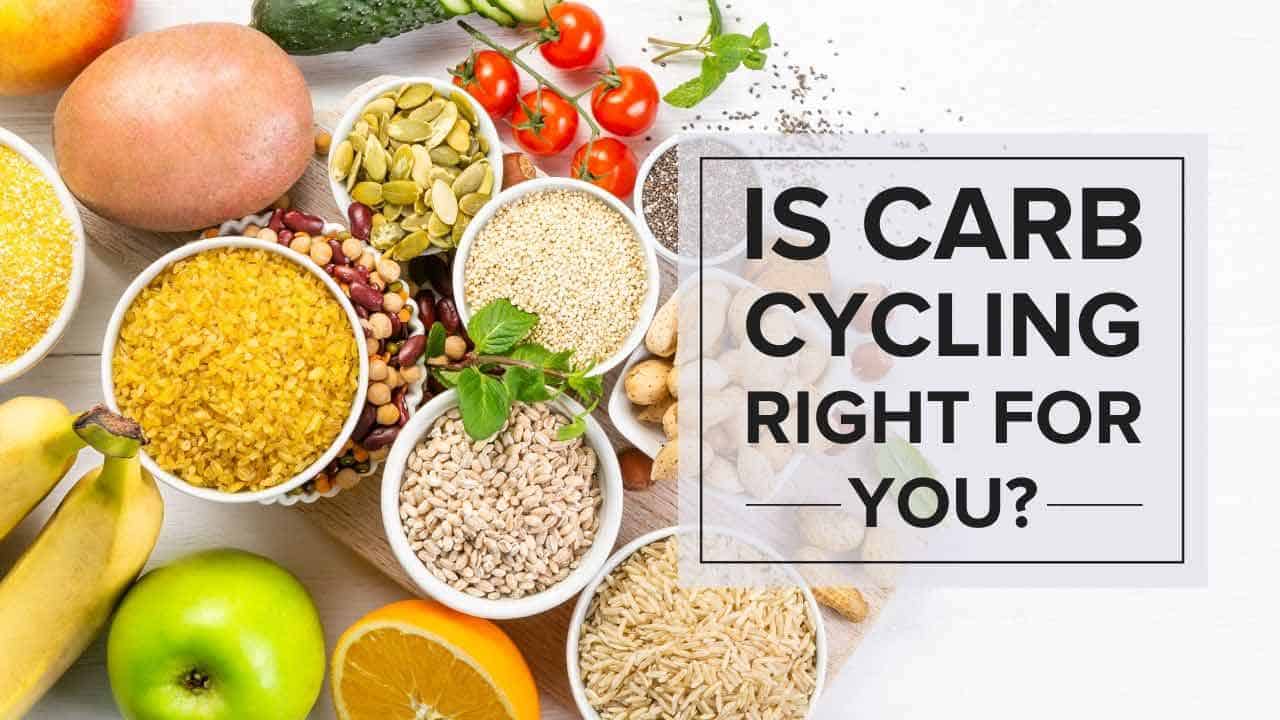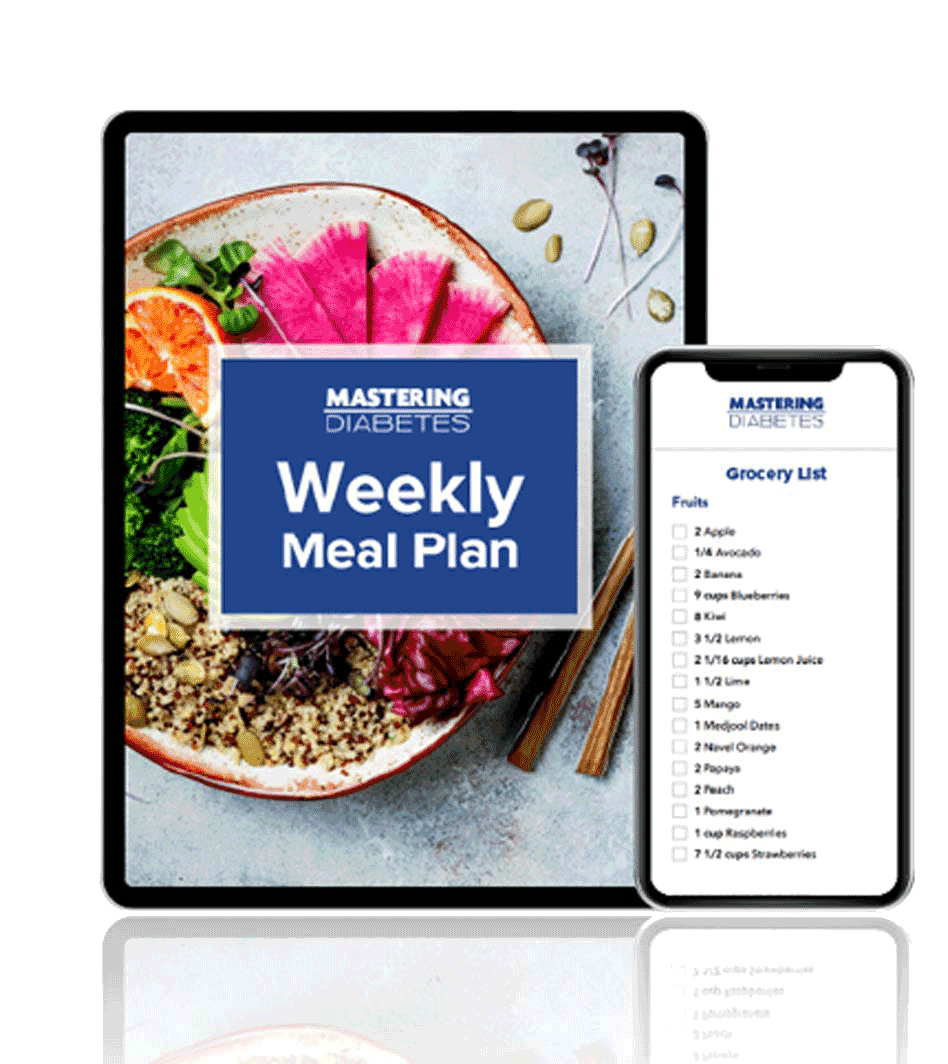
What Is Carb Cycling?
Understanding carbohydrates (also known as “carbs”) can be a very confusing topic in today’s world.
On the internet today, there are many health experts who recommend lowering your carbohydrate intake, advocating that carbohydrates cause conditions like insulin resistance, diabetes, and obesity.
On the other hand, different health experts suggest increasing your carbohydrate intake from whole foods to reduce your risk of those same chronic health conditions.
To make matters more confusing, many nutrition experts now recommend carb cycling – a strategy which alternates periods of increased carbohydrate intake and periods of low carbohydrate intake, in order to lose weight, overcome a weight loss plateau, or optimize athletic performance.
In this article, we’ll explore the theory behind carb cycling and some of the health benefits that it can have in the short-term. Then, we’ll touch on the fact that carb cycling probably isn’t the right choice if you’re trying to improve your diabetes health, and compare it to some other popular diets.
How Does Carb Cycling Work?

Simply stated – think of carb cycling as carb manipulating.
When you carb cycle, you manipulate the amount of carbohydrate that you eat in an effort to achieve your desired health outcome. Many proponents of carb cycling base their recommendations on your level of physical activity, varying the amount of carbohydrates you eat based on your training schedule.
On training days you’re suggested to eat a high-carbohydrate diet to fill glycogen stores in your muscle and liver, whereas on rest days you are suggested to restrict your carbohydrate intake in an effort to burn more fat.
In this way, carb cycling is supposedly alternating days of ”carb burning” and days of “fat burning,” flipping a metabolic switch between the two.
Most advocates suggest maintaining a consistent protein intake so that on low-carb days you eat a high-fat diet and on high-carb days you eat a low-fat diet.
The theory is that high-energy days allow for muscle-building and glycogen depletion from exercise. Then, on low-activity days, muscle continues to build, while you restrict your carbohydrate intake and calorie intake, helping to burn fat.
High Carb Days
Most carbohydrate cycling plans correspond to a training schedule, where you consume more carbohydrate energy on high-intensity training days to provide the energy to exercise and build muscle.
Experts suggest eating 2-2.5 grams of carbohydrate per pound of body weight on high-carb days.
In addition, some proponents recommend taking one day per week or one day per two weeks to “re-feed”. On these days, you’re encouraged to overeat your daily caloric requirements to help overcome the negative effects of being in a caloric deficit.
Low Carb Days
If you’re following a training program, most proponents of carb cycling tie low carb days into your rest days, focusing on ingesting fewer carbs so that your body focuses on burning fat.
There are varying opinions on how many grams of carbohydrate to eat on a low carb days, ranging from 0-0.5 grams of carbohydrates per pound of body weight.
Carb Cycling Diet Health Benefits

One of the main benefits of carb cycling is changing your body composition (losing fat and gaining muscle), which is most effective in tandem with a training plan. Below, we’ll go into some of the direct and secondary benefits of this dietary strategy.
*Note: The research is still somewhat limited on the effects of carb cycling without a dedicated training plan. If you’re looking to lose weight, lower your risk for chronic conditions, and improve your overall health, we’ll touch on some very beneficial diets that can do this at the bottom.
Weight Loss
The weight-loss benefits of low-carb diets are well documented, so it follows that a low-carb diet in tandem with reduced calorie intake (another major contributor to weight loss) would result in a significant reduction in body fat and body weight.
Add in the intense training that often accompanies a carb cycling diet, and the resulting fat loss can result in a significant change in body composition.
Build Muscle
Though there are many diets that can help build muscle mass in tandem with exercise, carb cycling aims to provide an additional benefit in that it limits excess fat gain. This can be a benefit for athletes who race (for whom lower weight means more efficiency), as well as for bodybuilders.
Regulate Blood Glucose (Blood Sugar)
There are a number of ways to help regulate blood glucose, and carb cycling hits two of the major ones by stimulating weight loss and increased exercise.
It’s worth noting that a reduced carbohydrate diet high in protein and fat can also decrease your blood glucose in the short-term, independent of weight loss and increased exercise.
However, these diets actually drastically increase your insulin resistance in the long term, which can actually increase your risk for prediabetes and type 2 diabetes. You can learn more about the myths of low carb diets and some of the dangers of these diets here.
And make no mistake about it – insulin resistance is a major condition that underlies many chronic metabolic diseases, including (but not limited to) type 1 diabetes, type 1.5 diabetes, type 2 diabetes, prediabetes, gestational diabetes, coronary artery disease, atherosclerosis, cancer, high cholesterol, high blood pressure, obesity, polycystic ovary syndrome (PCOS), peripheral neuropathy, retinopathy, Alzheimer’s disease, chronic kidney disease, and fatty liver disease.
Endurance Athletes
For endurance athletes, it’s been proven that periods of ‘carb loading’ can increase glycogen stores in your liver, providing an extra reserve of energy.
Carb cycling integrates some of these benefits if high-carb meals precede periods of exercise. Since these diets are traditionally low in carbohydrates, the sudden spike causes glycogen to stockpile in the liver, which is then available during exercise.
Potentially Easier to Stick To
Many proponents of carb cycling have suggest that carb cycling is one of the easier dieting methods to maintain in the long-term.
This is because your eating habits stay relatively stable, don’t require as much portion control, and include high-carb days and re-feeding days that can provide a reward and sense of balance throughout the week.
Carb Cycling Meal Plan

One of the most common recommendations for carb cycling includes two high-carb days, two medium-carb days, and three low-carb days.
What this might look like with a training schedule aimed at building muscle mass is as follows:
There are many programs online that go into further depth, so you can dial in your carb cycling program to your exact training schedule.
What Foods Can You Eat When Carb Cycling?
Technically there’s no restrictions as to the foods that you eat when carb cycling, as long as you follow the prescribed carbohydrate guidelines.
However, we heavily recommend sticking to a plant-based diet high in complex carbs as much as possible, due to the various health risks that can be associated with meat consumption. Below are some recommended sources of each macronutrient, as well as some foods to avoid.
Green Light | Yellow Light | Red Light |
|---|---|---|
All fruits (including all shapes, sizes, and textures) | Whole grain or bean pastas | All red meat (beef, lamb, ham, pork, bacon, veal, sausage) |
All non-starchy vegetables | Whole grain cereals | All white meat (chicken, turkey) |
All starchy vegetables (potatoes, sweet potatoes, squash, and root vegetables) | Refined grains (ex: rolled oats, barley flakes, puffed rice) | Fish (salmon, tuna, shellfish etc.) |
All legumes, including beans, peas, and lentils | Whole grain breads and tortillas | Eggs (both egg whites and egg yolks) |
Intact whole grains | Avocados | All dairy products (cheese, milk, yogurt, butter, ghee, ice cream, sour cream etc.) |
Herbs and spices | Nuts | All refined oils (olive oil, coconut oil, avocado oil, canola oil, etc.) |
Cell | Seeds | All refined sugars (table sugar, evaporated cane juice, brown sugar, high fructose corn syrup, etc.) |
Cell | Coconut Meat | Cell |
Cell | Soybeans and processed soy products including tofu and tempeh | Cell |
Is Carb Cycling Safe?

For healthy individuals who avoid processed foods and maintain an appropriate caloric balance, the carb cycling dietary strategy tends to be relatively effective with limited side effects.
However, one aspect of any low carb dietary strategy, including carb cycling, is that they by default tend to result in high-fat, high-protein diets, which significantly increase your risk for insulin resistance, the underlying condition that influences all forms of diabetes.
When paired with exercise and training, the side effects of these diets can be mitigated, but in the long-term can possibly result in very athletic individuals who are still classified as living with diabetes.
Before starting any new dietary strategy, we recommend working with a dietitian or nutritionist, and monitoring your health closely (especially your insulin resistance and cholesterol), to understand the full scope of these changes on your body.
Can You Carb Cycle on the Keto Diet?
By default, no. The ketogenic diet is a high-fat, low-carb diet by design, which means that the high-carb days of carb cycling will break ketosis and disrupt the ketogenic process.
This actually isn’t a bad thing. We’re strong believers that the keto diet provides short term results that can be disastrous in the long-term, and that there are many, better ways to get the same results.
Carb Cycling Meal Plan for Females
Currently, there is no evidence-based research that carb cycling in and of itself specifically affects women in any adverse way.
However, with any dietary plan that includes a caloric deficit and weight loss, there is potential for changes to your mood, hormonal balance, general comfort, and overall health. However, these possible changes can happen regardless of gender.
Is Carb Cycling for You?

Determining which dietary strategy is right for you depends on your goals. If you’re looking to gain muscle and lose fat in tandem with a high-activity training strategy, then carb cycling may be right for you.
However, if you’re looking for a long term strategy to lose weight, or to improve your overall health and remain at a healthy weight, then there may be more effective dietary plans. We’ll touch on the pros and cons of some below.
Carb Cycling vs Keto
Carb cycling and ketogenic diets both provide short-term weight loss, which can have a positive effect on your overall health especially if you’re overweight.
However, in the long-term, carb cycling and ketogenic diets may present significant health risks.
Keto and low-carb diets can increase insulin resistance in the long-term, leading to an increased risk of many chronic health conditions including diabetes.
We wrote about this extensively in the Mastering Diabetes book, so if you haven’t picked up a copy then this is your best resource for understanding both the short-term and long-term implications.
The Final Word: If you’re looking for improved athletic performance, carb cycling may be helpful. However, if you’re simply looking to lose weight or improve your overall health, eating a wide variety of plants is a stronger option than a carb cycling diet.
Carb Cycling vs Intermittent Fasting
Both carb cycling and intermittent fasting implement strategies between heightened and lowered states of food consumption. However, while carb cycling maintains a baseline level of calories day to day, intermittent fasting involves prolonged periods of zero calorie intake.
The science behind each is slightly different. While carb cycling focuses on altering the contents of your diet, intermittent fasting induces long periods of a biological process called autophagy, which has ample benefits for your metabolic health and weight loss.
Still, it’s hypothetically possible to both carb cycle and intermittent fast, as these strategies are not mutually exclusive, but the exact scheduling of cycles, fasts, and training might be difficult.
The Final Word: Both of these strategies have weight-loss benefits, so the key is choosing which additional benefits are right for you. Carb cycling provides a boost to training, while intermittent fasting improves your overall health (immunity, lower risk of chronic disease).
Carb Cycling vs Low-Carb Diets
See above for reference to ketogenic diets in which we explain the long-term effects of eating a low-carb diet.
Carb Cycling vs Macro Counting
Macro counting isn’t really a dietary strategy per se, as much as it is the building block upon which other diets are based.
The truth is that carb cycling, ketogenic diets, paleo diets, and low-fat, plant-based, whole-food diets may all reduce the severity of insulin resistance, and are all based on manipulating your macronutrient intake.
Carb Cycling vs Calorie Deficit
A calorie deficit is a part of many different weight loss diets, including many varieties of carb cycling.
Rather than focusing on specific macronutrients, calorie deficits simply follow the fundamental strategy of inducing a calorie deficit to lose weight.
The Final Word: If you eat less than your calorie requirements, you will lose weight, a strategy that can be added to any macronutrient-based dietary plan, including carb cycling.
Work with the Experts
Whether you’re looking to lose weight, gain muscle, combat diabetes, reverse insulin resistance, or simply improve your overall health and reduce your risk of chronic health conditions, your diet is key.
For almost all cases, we recommend a low-fat, plant-based, whole-food diet that’s high in natural carbohydrates, as these diets can be tailored to fit your exercise and fitness goals while minimizing any risks of long-term health conditions.
If you’d like to learn more, our method can dramatically help. We have decades of experience helping thousands of people improve their health through their diet, and can help you customize a plan that works for you.
Stop Guessing What to Eat
Get Delicious Recipes Sent to Your Inbox Every Week!

Discover the custom-designed Weekly Meal Plan that gives you clarity on what to eat and how to shop to simplify your journey to lower blood sugar, weight loss, and your best A1c




